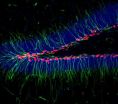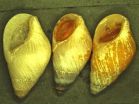(Press-News.org) They say it's the little things that count, and that certainly holds true for the channels in transmembrane proteins, which are small enough to allow ions or molecules of a certain size to pass through, while keeping out larger objects. Artificial fluidic nanochannels that mimic the capabilities of transmembrane proteins are highly prized for a number of advanced technologies. However, it has been difficult to make individual artificial channels of this size – until now.
Researchers with the U.S. Department of Energy (DOE)'s Lawrence Berkeley National Laboratory (Berkeley Lab) have been able to fabricate nanochannels that are only two nanometers (2-nm) in size, using standard semiconductor manufacturing processes. Already they've used these nanochannels to discover that fluid mechanics for passages this small are significantly different not only from bulk-sized channels, but even from channels that are merely 10 nanometers in size.
"We were able to study ion transport in our 2-nm nanochannels by measuring the time and concentration dependence of the ionic conductance," says Arun Majumdar,
Director of DOE's Advanced Research Projects Agency – Energy (ARPA-E), who led this research while still a scientist at Berkeley Lab. "We observed a much higher rate of proton and ionic mobility in our confined hydrated channels – up to a fourfold increase over that in larger nanochannels (10-to-100 nm). This enhanced proton transport could explain the high throughput of protons in transmembrane channels."
Majumdar is the co-author with Chuanhua Duan, a member of Majumdar's research group at the University of California (UC) Berkeley, of a paper on this work, which was published in the journal Nature Nanotechnlogy. The paper is titled "Anomalous ion transport in 2-nm hydrophilic nanochannels."
In their paper, Majumdar and Duan describe a technique in which high-precision ion etching is combined with anodic bonding to fabricate channels of a specific size and geometry on a silicon-on-glass die. To prevent the channel from collapsing under the strong electrostatic forces of the anodic bonding process, a thick (500 nm) oxide layer was deposited onto the glass substrate.
"This deposition step and the following bonding step guaranteed successful channel sealing without collapsing," says Duan. "We also had to choose the right temperature, voltage and time period to ensure perfect bonding. I compare the process to cooking a steak, you need to choose the right seasoning as well as the right time and temperature. The deposition of the oxide layer was the right seasoning for us."
The nanometer-sized channels in transmembrane proteins are critical to controlling the flow of ions and molecules across the external and internal walls of a biological cell, which, in turn, are critical to many of the biological processes that sustain the cell. Like their biological counterparts, fluidic nanochannels could play critical roles in the future of fuel cells and batteries.
"Enhanced ion transport improves the power density and practical energy density of fuel cells and batteries," Duan says. "Although the theoretical energy density in fuel cells and batteries is determined by the active electrochemical materials, the practical energy density is always much lower because of internal energy loss and the usage of inactive components. Enhanced ion transport could reduce internal resistance in fuel cells and batteries, which would reduce the internal energy loss and increase the practical energy density."
The findings by Duan and Majumdar indicate that ion transport could be significantly enhanced in 2-nm hydrophilic nanostructures because of their geometrical confinements and high surface-charge densities. As an example, Duan cites the separator, the component placed between the between the cathode and the anode in batteries and fuel cells to prevent physical contact of the electrodes while enabling free ionic transport.
"Current separators are mostly microporous layers consisting of either a polymeric membrane or non-woven fabric mat," Duan says. "An inorganic membrane embedded with an array of 2-nm hydrophilic nanochannels could be used to replace current separators and improve practical power and energy density."
The 2-nm nanochannels also hold promise for biological applications because they have the potential to be used to directly control and manipulate physiological solutions. Current nanofluidic devices utilize channels that are 10-to-100 nm in size to separate and manipulate biomolecules. Because of problems with electrostatic interactions, these larger channels can function with artificial solutions but not with natural physiological solutions.
"For physiological solutions with typical ionic concentrations of approximately 100 millimolars, the Debye screening length is 1 nm," says Duan. "Since electrical double layers from two-channel surfaces overlap in our 2-nm nanochannels, all current biological applications found in larger nanochannels can be transferred to 2-nm nanochannels for real physiological media."
The next step for the researchers will be to study the transport of ions and molecules in hydrophilic nanotubes that are even smaller than 2-nm. Ion transport is expected to be even further enhanced by the smaller geometry and stronger hydration force.
"I am developing an inorganic membrane with embedded sub-2 nm hydrophilic nanotube array that will be used to study ion transport in both aqueous and organic electrolytes,' Duan says. "It will also be developed as a new type of separator for lithium-ion batteries."
INFORMATION:
This work was supported by DOE's Office of Science, plus the Center for Scalable and Integrated Nanomanufacturing, and the Center of Integrated Nanomechanical Systems at UC Berkeley.
Berkeley Lab is a U.S. Department of Energy national laboratory located in Berkeley, California. It conducts unclassified scientific research and is managed by the University of California for the DOE Office of Science. Visit our Website at http://www.lbl.gov.
Tiny channels carry big information
2010-12-15
ELSE PRESS RELEASES FROM THIS DATE:
New survey device gets better information on teenage sexual behavior
2010-12-15
PROVIDENCE, R.I. [Brown University] — Brown University sociologists have developed a device to gather more reliable data about risky sexual behavior among Ethiopian teenagers and young adults than conventional face-to-face interviews can produce. Simple, portable, low-cost, and low-tech, the group's new nonverbal response card allows respondents to communicate nonverbally and confidentially during face-to-face interviews. Professors of sociology David Lindstrom and Dennis Hogan, and postdoctoral research associate Megan Klein Hattori published their findings in the December ...
Special section on stigma in Perspectives on Psychological Science: Group differences, not deficits
2010-12-15
Psychological scientists are faced with the arduous task of identifying distinctions between humans without stigmatizing groups of people based on these differences. In this special section of Perspectives on Psychological Science, a journal of the Association for Psychological Science, experts present reasons for why differences in gender, race, sexual orientation, and culture should not be framed as deficits within the field of psychology.
Stigma From Psychological Science: Group Differences, Not Deficits—Introduction to Stigma Special Section (http://pps.sagepub.com/content/5/6/687.full) ...
CSHL scientists identify elusive neuronal targets of deep brain stimulation
2010-12-15
Cold Spring Harbor, N.Y. – Shooting steady pulses of electricity through slender electrodes into a brain area that controls complex behaviors has proven to be effective against several therapeutically stubborn neurological and neuropsychiatric disorders. Now, a new study has found that this technique, called deep brain stimulation (DBS), targets the same class of neuronal cells that are known to respond to physical exercise and drugs such as Prozac.
The study, led by Associate Professor Grigori Enikolopov, Ph.D., of Cold Spring Harbor Laboratory (CSHL), is the cover ...
The ethics of biofuels
2010-12-15
In the world-wide race to develop energy sources that are seen as "green" because they are renewable and less greenhouse gas-intensive, sometimes the most basic questions remain unanswered.
In a paper released today by the School of Public Policy at the University of Calgary, authors Michal Moore, Senior Fellow, and Sarah M. Jordaan at Harvard University in the Department of Earth and Planetary Sciences, look at the basic question of whether these energy sources are ethical.
In addition to arguing that the greenhouse gas benefits of biofuel are overstated by many policymakers, ...
Researchers discover new signaling pathway linked to inflammatory disease
2010-12-15
Scientists at the University of California, San Diego School of Medicine have described for the first time a key inhibitory role for the IL-1 signaling pathway in the human innate immune system, providing novel insights into human inflammatory bowel disease (IBD) and potential new treatments.
The research, led by Jose M. Gonzalez-Navajas, PhD, and Eyal Raz, MD, a professor of medicine at UC San Diego, is published as a Brief Definitive Report in the December issue of The Journal of Experimental Medicine.
The researchers report that signaling by the interleukin 1 receptor ...
Fighting flu in newborns begins in pregnancy
2010-12-15
A three-year study by Yale School of Medicine researchers has found that vaccinating pregnant women against influenza is over 90 percent effective in preventing their infants from being hospitalized with influenza in the first six months of life. Published in the December 15 issue of Clinical Infectious Diseases, the study builds on preliminary data the research team presented last year at the Infectious Disease Society of America in Philadelphia.
Influenza is a major cause of serious respiratory disease in pregnant women and of hospitalization in infants. Although the ...
Scripps scientists see the light in bizarre bioluminescent snail
2010-12-15
Two scientists at Scripps Institution of Oceanography at UC San Diego have provided the first details about the mysterious flashes of dazzling bioluminescent light produced by a little-known sea snail.
Dimitri Deheyn and Nerida Wilson of Scripps Oceanography (Wilson is now at the Australian Museum in Sydney) studied a species of "clusterwink snail," a small marine snail typically found in tight clusters or groups at rocky shorelines. These snails were known to produce light, but the researchers discovered that rather than emitting a focused beam of light, the animal uses ...
Mothers' diets have biggest influence on children eating healthy
2010-12-15
EAST LANSING, Mich. — As health professionals search for ways to combat the rise in obesity and promote healthy eating, new research reveals a mother's own eating habits – and whether she views her child as a 'picky eater' – has a huge impact on whether her child consumes enough fruits and vegetables.
A study by professor Mildred Horodynski of Michigan State University's College of Nursing looked at nearly 400 low-income women (black and non-Hispanic white) with children ages 1-3 enrolled in Early Head Start programs. Results show toddlers were less likely to consume ...
IBEX makes first images of magnetotail structures, dynamic interactions occurring in space
2010-12-15
Invisible to the naked eye, yet massive in structure around the Earth is the magnetosphere, the region of space around the planet that ebbs and flows in response to the million-mile-per-hour flow of charged particles continually blasting from the Sun. NASA's Interstellar Boundary Explorer (IBEX) spacecraft, designed to image the invisible interactions occurring at the edge of the solar system, captured images of magnetospheric structures and a dynamic event occurring in the magnetosphere as the spacecraft observed from near lunar distance.
The data provides the first ...
UT researcher finds power and corruption may be good for society
2010-12-15
They are familiar scenes: politicians bemoaning the death of family values only for extramarital affairs to be unveiled or politicians preaching financial sacrifice while their expense accounts fatten up.
Moral corruption and power asymmetries are pervasive in human societies, but as it turns out, that may not be such a bad thing.
Francisco Úbeda, an evolutionary biology professor at the University of Tennessee, Knoxville, and Edgar Duéñez of Harvard University found that power and corruption may play a role in maintaining overall societal cooperation.
A report of ...




